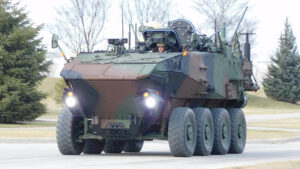The Marine Corps said Thursday it has officially started government testing of the Advanced Reconnaissance Vehicle (ARV) prototypes, with the results set to help inform whether to take the program into production.
After receiving General Dynamics Land Systems
[GD] and Textron Systems’ prototypes in December, the Marine Corps said the initial evaluation period is expected to be completed in the third quarter of this year.

“During the competitive prototyping phase, testing will focus on mobility in complex terrains common to the ARV mission profile, properly stressing the Command, Control, Communications and Computers, Unmanned Air Systems (C4/UAS) capabilities, other vehicle performance and characteristic testing,” the Marine Corps said in a statement. “The test data will support evaluation by the Marine Corps to determine an achievable requirement.”
In July 2021, the Marine Corps selected Textron Systems and GD Land Systems for the 22-month ARV prototyping effort and tasked each company with delivering one test vehicle for government testing (Defense Daily, July 16 2021).
The Marine Corps has also previously tasked BAE Systems with integrating a suite of C4/UAS capabilities onto an Amphibious Combat Vehicle (ACV), which the company currently builds for the service, to study if such a platform could meet the ARV mission requirements.
“A third prototype, offered by BAE Systems, is also undergoing evaluation to provide the Marine Corps with trade space between a government off-the-shelf and purpose-built solution,” the Marine Corps said on Thursday.
Textron said in December it delivered its Cottonmouth vehicle for the ARV prototyping effort to the Marine Corps following the company’s own verification testing period, which it said covered “mobility, swim capability, [vehicle electronics] integration and C4/UAS mission capabilities” (Defense Daily, Dec. 14).
GD Land Systems noted in December, along with its ARV prototype, it would also be providing a blast hull for survivability testing and a system integration lab for the government evaluation period (Defense Daily, Dec. 21).
The lead variant for the ARV is set to feature a C4/UAS payload, with the Marine Corps noting the platform will “employ transformational sensors, communications, and combat capabilities to collect and communicate information, while integrating robotics and artificial intelligence technologies into manned-unmanned teams.”
“The ARV will enable a crew to sense the operating environment and convey that information using advanced on-board sensors and networked communications systems that are augmented by unmanned systems to detect, recognize, identify, and report threats at extended ranges,” the Marine Corps said on Thursday.
A Marine Corps sources sought notice released in December 2021 detailed plans for the C4/UAS platform and a precision fires version to serve as the first two ARV variants, to be followed by a 30mm cannon version, a recovery variant, a logistics variant and a counter-UAS variant in follow-on phases.
BAE Systems told Defense Daily last May it’s eyeing the ARV program as an opportunity to build out additional variants of the ACV, with the company showcasing a C4/UAS version of the vehicle and a new Organic Precision Fires concept vehicle at the Modern Day Marine conference in Washington, D.C. (Defense Daily, May 11 2022).
On Thursday, BAE Systems also announced it successfully tested with Lockheed Martin [LMT] Skunk Works’ Stalker and Indago small uncrewed aerial systems (UAS) from its ACV C4/UAS vehicle as part of the contractor verification testing period.
“Both UAS will provide unprecedented, long-endurance reconnaissance capabilities to support the U.S. Marine Corps’ expeditionary warfare and battle management capabilities aboard the ACV C4/UAS,” BAE Systems said in a statement. “Skunk Works’ Stalker and Indago UAS provide industry-leading endurance, a broad operating envelope, and an open systems architecture to allow them to execute diverse and demanding missions while maintaining a small operational footprint and crew requirement.”